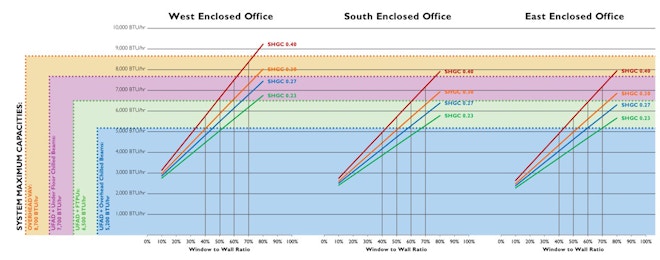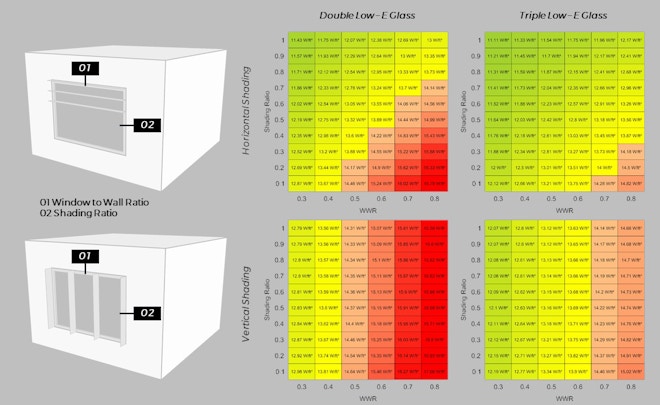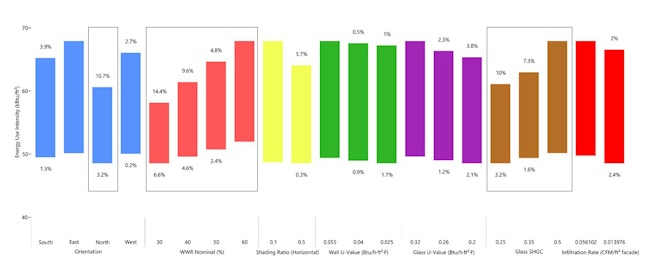Read on.
Energy conservation code updates promise to reshape the way facades are designed
Cities have long mandated compliance with energy codes that provide prescriptive efficiency requirements for the thermal envelope, lighting, and mechanical systems. As an alternative compliance path, dynamic energy modeling can be used to demonstrate equivalent performance via tradeoffs between the efficiencies of different building systems when compared to a code prescribed baseline.
...the replacement cycle for the façade is typically much longer than the other systems, potentially locking the building into suboptimal performance throughout its lifetime.
Ever-increasing performance requirements in the latest version of the energy codes are compelling project teams to consider the thermal performance of the building envelope more rigorously than ever before. One reason is simply that additional savings are needed as many municipalities ratchet up efficiency requirements towards achieving their respective net zero carbon emissions goals by 2050.
But another critical consideration in the newfound emphasis on the building façade is that many of these code updates are incorporating new backstops that limit how much worse the envelope can perform compared to the prescriptive requirements even if the overall energy reductions are achieved through tradeoffs. For example, New York City’s 2020 Energy Code limits hotel and multifamily envelopes to no more than 15% worse than prescriptive, while all other building types must be within 7%. Similar backstops are in effect in other cities such as Seattle and Boston.
Under previous iterations of the energy code, architectural designers were able to rely heavily on HVAC and lighting improvements to meet the efficiency requirements, freeing them up to design the façade with considerably less emphasis on environmental responsiveness and energy performance. The incongruity of this approach is that the replacement cycle for the façade is typically much longer than the other systems, potentially locking the building into suboptimal performance throughout its lifetime.
High performance facades that reduce heating and cooling loads through improved thermal resistance (including the reduction of thermal bridging), effective management of solar heat gain, and higher levels of airtightness are essential for meeting these new energy targets. Furthermore, reducing the loads of the building can enable the use of HVAC systems that possess limited peak capacity but higher efficiency, such as chilled beams.
Therefore, the careful consideration of the façade as an integrated part of building performance can unlock the potential for additional energy savings through enabling efficient mechanical system selection. A good passive performing façade is also a more resilient façade, protecting the occupants from thermally uncomfortable conditions even if the mechanical systems can’t operate due to a power failure.

Figure 1:Reducing the cooling loads through the design of the facade opens up the potential use of high performance HVAC systems.
The complexities of the façade’s interaction with HVAC system selection and other design considerations like thermal and visual comfort can stymie many project teams who fail to investigate the performative aspects of the building envelope early on. Costly delays can result from pursuing a design direction and only finding out later that changes are required to meet new energy code requirements.
It is imperative to develop an integrated and iterative modeling regiment from the earliest project phases to ensure that the design coalesces around an effective performance strategy. Engaging with energy and performance modeling as a design tool can serve to inform architectural decisions rather than just evaluate the consequences of them.

Figure 2: Parametric modeling can identify façade properties that will meet or exceed the thresholds of new energy code requirements even in early design phases.
Parametric modeling tools can assess a wide range of potential design scenarios and identify multiple compliance pathways, searching through different combinations of window-to-wall ratio, placement of windows, assembly U-Values, glazing selection, and other façade design parameters. The project stakeholders can utilize this information to identify high impact design parameters that fit within their design intentions, budgetary constraints, and performance requirements.

Figure 3: Sensitivity analysis can identify facade parameters that have the greatest influence on energy performance.
Incorporating the effects of thermal bridging on the energy models can give a more accurate sense of the true performance of the envelope. Many of the new codes are starting to require documentation of thermal bridging conditions which previously were not accounted for in most typical energy modeling practices.
De-carbonizing the built environment is a critical initiative needed to prevent the worst effects of climate change. New energy codes are encouraging project teams to step up the performance of their building designs to meet these goals, with a particular emphasis on the façade. Proper use of modeling tools can be utilized even in early design phases to guide the project to more energy efficient design solutions.

Elliot Glassman
Building Performance Group Leader
Cannon Design
Elliot Glassman is a Senior Associate and Senior Technical Principal with Built Ecology, WSP's high performance and sustainability group. He is also the National Leader of Computational Design for Building Systems and a charter member of WSP's global computational design group WSPnext.
Looking for something specific?
Search our extensive library.
FTI’s SKINS email is the central source for the latest in building skin trends and research.
All emails include an unsubscribe link. You may opt out at any time. See our privacy policy.









